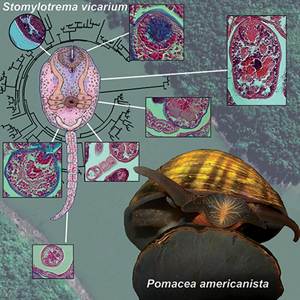Published online by Cambridge University Press: 15 September 2021

The adult fluke Stomylotrema vicarium (Stomylotrematidae, Microphalloidea) was described for the first time in Theristicus caerulescens in 1901, but the complete life cycle has remained unknown to date. Here, we found a stomylotrematid trematode in the digestive gland of the endemic apple snail Pomacea americanista. The digestive gland's tubuloacini were compressed by the trematode larvae placed on connective tissues and haemocoel spaces. Non-virgulate, stylet-bearing cercariae showed three pairs of penetration glands with a body, oral sucker and stylet morphometrically similar to those of stylet-bearing, unencysted young metacercariae of S. vicarium found in the aquatic coleopteran Megadytes glaucus, and at a lesser extent with cercariae of S. gratiosus found in the apple snail Pomacea maculata. The larvae molecular phylogeny was inferred using the markers rRNA 28S and ITS1, being these sequences grouped with the sequences of S. vicarium obtained from adult flukes. Together, these findings indicate that the life cycle of S. vicarium begins in P. americanista, thus supporting the hypothesis that the ampullariid snails act as a first intermediate host.